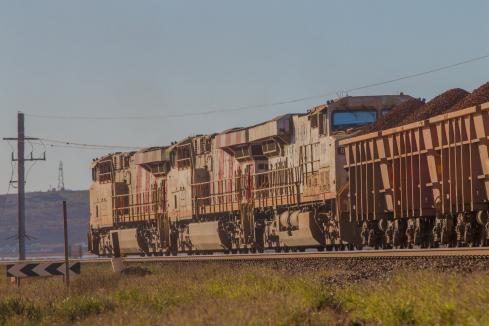With burgeoning expectations for a new lithium wave to soon appear on the horizon, Chariot Corporation – the biggest lithium landowner in the US – has made a strategy shift at its Black Mountain project in Wyoming to get ready for the ride. The plan is to take advantage of Wyoming’s unique mining regulations in order to scale a future mine in line with the lithium market.


With burgeoning expectations for a third lithium wave to soon appear on the horizon, Chariot Corporation – the biggest lithium landowner in the United States – has made a strategy shift at its Black Mountain project in Wyoming to get ready for the ride.
The company’s plan is to take advantage of the State of Wyoming’s unique mining regulations – which we will explain shortly – in order to scale up a future mine in line with the lithium market.
And market punters have clearly liked what they have seen and heard, with Chariot’s share price jumping from an 11c close the day before it revealed the new strategy last Thursday, to double to a high of 22c today.
Management is making no secret about wanting to try and capitalise on a growing US lithium supply deficit created by the world’s second-biggest car market, by fast-tracking production of spodumene concentrate at its near-surface, lithium-rich Black Mountain project. It is a product seen as critical for electric vehicle (EV) production and the many lithium hydroxide refineries under construction in the nation’s south-west.
And the pivot towards the smaller-scale pilot mine and away from lithium exploring is far from just a trivial move, as management believes it has its foot on pretty much every potentially lithium-bearing pegmatite in the expansive US State of Wyoming – somewhere in the vicinity of 700 of them. It also comes during a period of depressed lithium prices, which have fallen more than 80 per cent in the past year, largely due to overproduction from China.
The price collapse has forced companies such as Chinese battery giant CATL to suspend production at certain mines. Albemarle, the world's top lithium miner, implemented a second round of cost cuts earlier this year and laid off workers.
However, many analysts believe the lithium price route has now bottomed out. While only time will tell if it can bounce back to the dizzying heights of 2022, it has perhaps created a buying opportunity for those more bullish on global producers.
In a massive move for the sector, it was confirmed this week that iron ore giant Rio Tinto will spend $US6.7 billion ($9.9 billion) in an all-cash takeover deal to acquire dual-listed producer, Arcadium Lithium. The ground-shaking agreement comes after Arcadium’s share price had dropped more than 60 per cent this year, leaving Rio licking its lips at what it believes to be an opportunistic takeover price.
Accordingly, Arcadium’s stock surged from a closing price of $4.18 last week to hit an intraday high of $8.25 yesterday – a boost of more than 97 per cent and with nearly 61 million shares changing hands.
Interestingly, Chariot director Neil Stuart was a founding director of Arcadium, which was formerly known as Orocobre and then Allkem before taking its current moniker after a high-profile merger completed early this year between the latter and US chemicals giant Livent. Stuart is now likely to be looking to see through a second success story as a founding director of yet another lithium junior.
Chariot says its latest gear change will also enable it to leverage off a helpful wrinkle in Wyoming’s favourable small-mine permitting system.
Wyoming’s regulatory framework allows a streamlined approval process to mining by imposing a 10-acre surface disturbance limit, without restricting the volume of mineralised material extraction. It will allow Chariot to swiftly bring the pilot mine online and target the US market, where supply chain disruptions and a reliance on foreign lithium supplies have highlighted the need for domestic production.
The company says the establishment of a pilot mine at Black Mountain also offers the potential to materially mitigate risks associated with a future large-scale development, by optimising grade control and its understanding of the mineralisation. Management’s immediate focus will be to define a small-scale lithium resource for the proposed pilot mine, while advancing its understanding of Black Mountain’s mineralisation and geology to identify targets for the delineation of a bigger resource.
Chariot plans to conduct a 4300m reverse-circulation (RC) drilling campaign, with 43 holes to be plugged into two key southern pegmatite outcrops that have previously exhibited promising grades and thicknesses from as little as 2m. Recent assays highlight the high-grade lithium, including a 15.48m intercept going 1.12 per cent lithium oxide from just 2.74m including 4.27m at 2.46 per cent lithium oxide and 128ppm tantalum oxide from 9.94m.
Management believes the pilot project’s near-term production will lay the foundation for revenues to support a bigger resource development in the future. The company is negotiating for a drilling contractor, with plans to kick off work as soon as a rig and crew are available.
Chariot Corporation managing director Shanthar Pathmanathan said: “We know we have great assets, so the real challenge for us is dilution. Getting to cash flow sooner helps us best manage dilution. Frankly, getting to cash flow sooner is more important to us than drilling out the next multi-hundred-tonne lithium resource – although Black Mountain could become this in time."
By processing mined materials on-site, the company believes it can reduce both transportation and construction costs, enhancing the project’s overall economics.
It has shipped a 200kg sample of mineralised diamond drill core from Wyoming to Perth in Western Australia for metallurgical testing under the supervision of METS Engineering Group. METS will provide guidance on the testwork program and plant design using its extensive experience on WA-based hard-rock lithium projects at the world-class Greenbushes and Pilgangoora mines.
As part of its broader vision, Chariot has also strengthened its presence in the lithium space through strategic acquisitions and partnerships.
Notably, the company holds a significant 24.1 per cent stake in Mustang Lithium and its now wholly-owned Horizon and Halo lithium claystone projects that lie in Nevada’s Big Smoky Valley. It is where recent operators Pan American Energy Corporation (PAC) and POWR Lithium Corporation (PLC), respectively, have decided to drop the projects due to adverse market conditions.
And that is a rather fortunate outcome for Mustang and its major shareholder, Chariot, as before leaping, PAC established a combined indicated and inferred lithium carbonate equivalent (LCE) resource totalling some 10.1 million tonnes at Horizon.
Additionally, Chariot wholly owns another claystone lithium project known as Resurgent, which straddles the US States of Nevada and Oregon and makes up its core lithium portfolio.
Resurgent sits within the McDermitt Caldera, which hosts two of the biggest lithium resources discovered in the US. The project lies in the same sediments as $1billion TSX-listed Lithium Americas’ Thacker Pass deposit, which has a mineral resource of 19.1 million tonnes LCE at 1334 parts per million lithium.
Chariot’s pivot to a pilot mine at Black Mountain appears to be a savvy and timely response to the widely-anticipated resurgence of the lithium price. By taking advantage of Wyoming’s regulatory benefits and developing a modular, scalable production facility, the company should be well-positioned to deliver spodumene concentrate to newly-constructed US refineries at a time when domestic lithium supply becomes critical.
Is your ASX-listed company doing something interesting? Contact: matt.birney@businessnews.com.au















